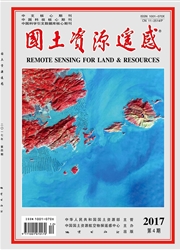

 中文摘要:
中文摘要:
为了对岷江上游"生态水"的估测提供有效的数据源和方法,利用高光谱遥感技术定量研究了植被反射光谱与植被含水率的关系,测定了研究区多个采样点棕榈叶片的反射光谱和对应的含水率,通过二者的相关分析和逐步回归的方法提取敏感波段;为避免敏感波段之间相关性影响,采用主成分分析法提取主成分,建立主成分与含水率的定量分析模型,并建立主成分与标准自变量的回归方程,然后建立各个标准变量与原始自变量(反射光谱敏感波段)的回归方程,最终转换为植被含水率与反射光谱之间的模型。结果表明:棕榈叶片反射光谱在454 nm,668 nm,1 466 nm,1 664 nm和1 924 nm波段处与含水率显著相关;采用主成分定量分析模型的估算值与实测值相关系数为0.92,均方根误差为0.06。
 英文摘要:
英文摘要:
In this paper,hyperspectral remote sensing technology was applied to the quantitative study of the relationship between the reflectance spectra of vegetation and vegetation moisture content,and reliable data were obtained for the study of vegetation water content as one of the "Eco-water"information parameters.Sensitive bands were extracted by relevance analysis and stepwise regression of the reflectance spectra and the moisture content of palm leaves collected in the sampling points.In avoidance of the interaction of sensitive bands,the relationship between principal constituents and moisture content was identified as a transition in the first place by extracting principal constituents using principal component analysis,the regression equation of every principal component and standard variables was established,the equation of regression between every standard variable and original variables was also established and,finally,the model of the relationship between vegetation moisture content and reflectance spectra was obtained from translating the transition model.The results showed that the reflectance spectra of palm leaves had significant correlation with vegetation water content at 454 nm,668 nm,1 466 nm,1 664 nm and 1 924 nm,and that the relative correlation between the predicted values obtained in the niche model and the monitoring values was 0.92,with the root mean square error being 0.06.
 同期刊论文项目
同期刊论文项目
 同项目期刊论文
同项目期刊论文
 期刊信息
期刊信息
